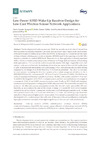Identificador persistente para citar o vincular este elemento:
https://accedacris.ulpgc.es/jspui/handle/10553/75828
| Título: | Low-power rfed wake-up receiver design for low-cost wireless sensor network applications | Autores/as: | Galante Sempere, David Ramos Valido, Dailos Khemchandani, Sunil Lalchand Del Pino Suárez, Francisco Javier |
Clasificación UNESCO: | 3307 Tecnología electrónica | Palabras clave: | Active Inductor Complementary Metal-Oxide Semiconductor (Cmos) Energy Efficient Integrated Transformer Low Power, et al. |
Fecha de publicación: | 2020 | Publicación seriada: | Sensors (Switzerland) | Resumen: | The development of wake-up receivers (WuR) has recently received a lot of interest from both academia and industry researchers, primarily because of their major impact on the improvement of the performance of wireless sensor networks (WSNs). In this paper, we present the development of three different radiofrequency envelope detection (RFED) based WuRs operating at the 868 MHz industrial, scientific and medical (ISM) band. These circuits can find application in densely populated WSNs, which are fundamental components of Internet-of-Things (IoT) or Internet-of-Everything (IoE) applications. The aim of this work is to provide circuits with high integrability and a low cost-per-node, so as to facilitate the implementation of sensor nodes in low-cost IoT applications. In order to demonstrate the feasibility of implementing a WuR with commercially available off-chip components, the design of an RFED WuR in a PCB mount is presented. The circuit is validated in a real scenario by testing the WuR in a system with a pattern recognizer (AS3933), an MCU (MSP430G2553 from TI), a transceiver (CC1101 from TI) and a T/R switch (ADG918). The WuR has no active components and features a sensitivity of about −50 dBm, with a total size of 22.5 × 51.8 mm2 . To facilitate the integration of the WuR in compact systems and low-cost applications, two designs in a commercial UMC 65 nm CMOS process are also explored. Firstly, an RFED WuR with integrated transformer providing a passive voltage gain of 18 dB is demonstrated. The circuit achieves a sensitivity as low as −62 dBm and a power consumption of only 528 nW, with a total area of 634 × 391 µm2 . Secondly, so as to reduce the area of the circuit, a design of a tuned-RF WuR with integrated current-reuse active inductor is presented. In this case, the WuR features a sensitivity of −55 dBm with a power consumption of 43.5 µW and a total area of 272 × 464 µm2, obtaining a significant area reduction at the expense of higher power consumption. The alternatives presented show a very low die footprint with a performance in line with most of the state-of-the-art contributions, making the topologies attractive in scenarios where high integrability and low cost-per-node are necessary. | URI: | https://accedacris.ulpgc.es/handle/10553/75828 | ISSN: | 1424-8220 | DOI: | 10.3390/s20226406 | Fuente: | Sensors (Switzerland)[ISSN 1424-8220],v. 20 (22), p. 1-16, (Noviembre 2020) |
| Colección: | Artículos |
Citas SCOPUSTM
15
actualizado el 08-jun-2025
Citas de WEB OF SCIENCETM
Citations
10
actualizado el 08-jun-2025
Visitas
145
actualizado el 07-dic-2024
Descargas
457
actualizado el 07-dic-2024
Google ScholarTM
Verifica
Altmetric
Comparte
Exporta metadatos
Los elementos en ULPGC accedaCRIS están protegidos por derechos de autor con todos los derechos reservados, a menos que se indique lo contrario.
